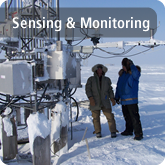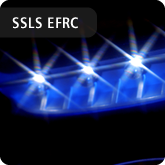The fundamental interaction governing light emission from semiconductor materials is the coupling between electronic states in the semiconductor and a local electromagnetic field. The current generation of solid-state lighting devices operates in the so-called “weak-coupling” regime, in which the rate of energy transfer between the electronic states and the local electromagnetic field is lower than the rates at which these states or fields relax. For a possible future generation of solid-state lighting devices, the Solid-State Lighting Science Energy Frontier Research Center is exploring the so-called “strong-coupling” regime, in which the rate of energy transfer between the electronic states and the local electromagnetic field is higher than the rates at which these states fields relax. In this regime, energy oscillates between the electronic states and the local electromagnetic field—so-called Rabi oscillations which manifest themselves as Rabi splittings in the electronic states and in measured optical emission spectra.
In a paper just published in NanoLetters, “Observation of Rabi Splitting from Surface Plasmon Coupled Conduction State Transitions in Electrically Excited InAs Quantum Dots,” we observe Rabi splitting between electronic states in InAs quantum dots and a surface-plasmon polariton field. The electronic states are populated by electrical excitation, and are conduction-band states connected by quantum-cascade-like intra-conduction-band transitions. The surface plasmon polariton field is supported by a metallic (Au) film in close proximity to the quantum dots, and the film perforated with holes arranged to facilitate coupling of the surface-plasmon polariton to free-space light.
The electroluminescence spectra for devices emitting in the 9-11 µm wavelength range show distinct spectral splittings that we believe, through comparisons with model calculations, arise from Rabi oscillations. This result indicates that electrically excited intra-conduction-band transitions in self-assembled quantum dot samples can be strongly coupled to surface-plasmon polaritons. A striking result of the research is that Rabi oscillations can be observed from a largely inhomogenously broadened medium of narrow linewidth oscillators. Beyond this, these results indicate that quantum dots and surface-plasmon polaritons show promise for quantum-optics experiments and for non-classical long-wavelength plasmonic optoelectronic devices.
The authors of the paper are: Brandon Passmore (EFRC student, Sandia Labs), David Adams (EFRC student, University of Massachusetts), Troy Ribaudo (EFRC student, University of Massachusetts), Dan Wasserman (EFRC external partner, University of Massachusetts), Stephen Lyon (Princeton University), Paul Davids (EFRC student, Sandia Labs), Weng Chow (EFRC scientist, Sandia Labs), and Eric Shaner (EFRC scientist, Sandia Labs).














 RSS
RSS Google+
Google+ Twitter
Twitter Facebook
Facebook LinkedIn
LinkedIn YouTube
YouTube Flickr
Flickr